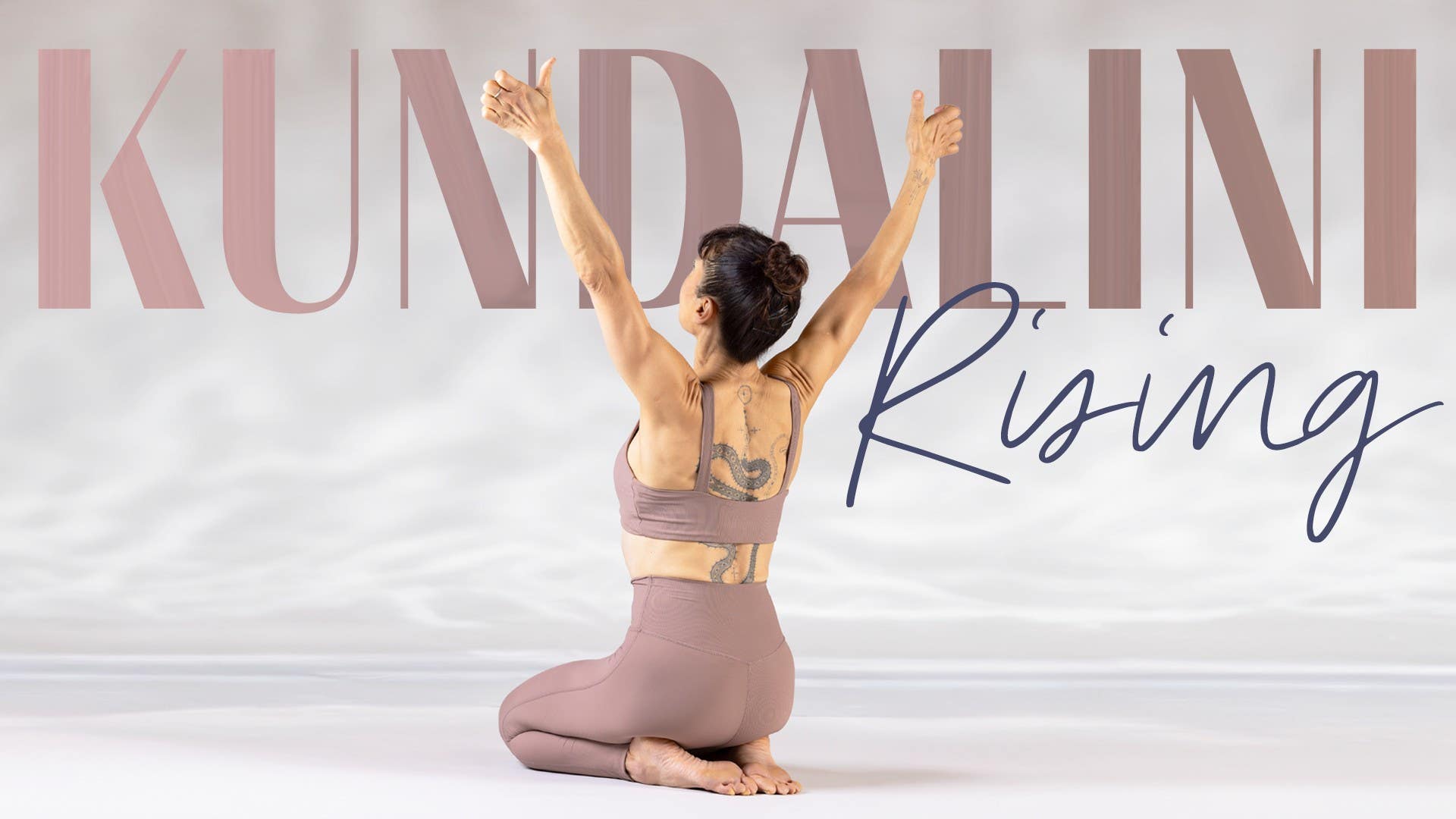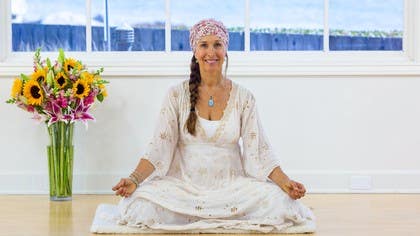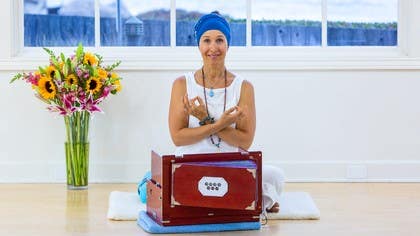Description
About This Video
Transcript
Read Full Transcript
Sat Naam and welcome to the foundational Kundalini yoga practices. We'll kind of dissect a few things today and see how we can get started by understanding this ancient sacred technology called Kundalini yoga. So one of the things that we look at is the 10 bodies. We talked about it a little bit in the Kundalini yoga introduction, but let's go a little bit deeper into it and see if we can dissect and understand what are the 10 bodies. Kundalini yoga looks at the 10 bodies in this way.
The first body is the soul body and that is what connects you to your own infinity. The second body is the negative mind and this is important because it's your protective mind. Don't cross the road, there's a car coming. That's important to have the negative mind working properly. The third one is the positive mind and this is the one that seeks pleasure and fulfillment in all experiences and brings positivity and an enlightened quality to all situations in life.
And then the neutral mind is the one that assesses pros, cons. Let's make an intuitive choice here. Let's make a neutral choice based on a higher frequency, based on intuition. So those are the first four minds and important to understand how it comes as a whole within the 10 bodies. Body number five is the physical body and it is our vessel, it is our sacred temple, it is that which the soul expresses itself.
Body number six is one of the six subtle, which is energetic body. So we work a lot with the subtle bodies in Kundalini yoga because we're so affected by them. Our nervous system, the way our glandular system works, our pituitary, our pineal, everything that regulates our emotions, our compulsions, is regulated by these 10 bodies, not just the physical body. So it's important to acknowledge these six energetic bodies. So let's go through them.
The first one was the soul body, which we touched on as number one. Now the sixth one is the arc line. The arc line runs energetically from earlobe to earlobe and it follows the path of the hairline. In ancient paintings, you would see Jesus or other holy figures with these halos around their head and initially that's what they're depicting is the arc line. The arc line is also the nucleus of your auric field.
So what happens through the arc line is this information from the world comes in and it dumps into the subconscious through the arc line. And why we meditate is to clear the subconscious because that is where we store the negativity, the traumas we've had, the paths we're not letting go of. Yogi Bhajan would refer to the subconscious mind as the storehouse of misery. And so we meditate to clear that. So the seventh body is the auric body, which is the nucleus, the container of your life force energy.
And when the auric field is strong, and that's why we do a lot of like arm exercises, right? We might do this for 11 minutes or we might do this for 11 minutes. We're building the auric field, which is the container for our life force energy for the way that we express ourselves and we express our creativity. And it really gives us a sense of confidence and security when the auric field is strong. Number eight is the pranic body, and that is all about breath and energy.
And of course, it's consistently feeding us with breath so that we can live this incredible and brief, precious human experience. Number nine is the subtle body. When we're connected to the subtle body, we're able to see beyond the realities of life, beyond our stories, and really connect with the divine play of life. And it's really a wonderful thing to be able to be in life and be present as a human being, but also see beyond the realities of this world and what's happening right now. Even in our own lives.
And number 10 is the radiant body. And this is our spiritual royalty and our radiance. It really is what you witness when you see somebody who has a great glow about them and you feel very drawn to them. That's a very strong, radiant body. And it really also gives you a lot of courage in your life.
Yogi Bhajan would say, it's not about the life you live, but it's about the courage you bring to the life you live. So that's a little very small summary of the 10 bodies. And in another episode, I'll be teaching awakening the 10 bodies, which is a Kriya, which really focuses on all of the 10 bodies and basically awakening them so that you can feel balanced, centered and energized. Let's talk a little bit about a daily practice. We talked about it a little bit in the introduction to Kundalini Yoga, but I just want to go into it a little bit deeper.
The whole science of Kundalini Yoga is about building positive habit. And the way that we do that is through 40 day practices or longer practices. Now why 40 days? It is says that it takes 40 days to build a positive habit or to break a negative habit, doing it every day consistently. If you can do it at the same time, that can help.
But just doing 40 days will help you to shift tremendously, whatever it is, whether it's something small or something huge. Just commit yourself for the 40 day practice and you will see results. So as human beings, we are creatures of habits, if you hadn't noticed. We are creatures of habits. We like to eat the same things.
We like to go to the same places. We like to do the same things. That's just how we operate in this physical humanness that we are. So the science of building positive habits through the Kriyas, through the meditations, through the pranayams is a complete system in and of itself. And as I stated earlier, there are thousands of Kriyas, meditations and breath pranayams that you can explore to really deal with whatever habit you're needing to conquer.
It's about conquering that habit and when you start to implement this new habit, like I'm going to get up early, half an hour earlier than I usually do and I'm going to do this pranayama and this Kriya and this chant for 40 days or you'll just pick one thing. I'm going to do this chant for 40 days. You will see after about three days, there will start to be a shift and the shift happens in the psyche and it's a profound shift. It happens in the subconscious mind. We start to feel lighter.
We start to feel more connected. We start to feel more compassion for ourselves and for others. So I highly recommend to find your way to a 40 day practice and give yourself an experience of conquering a negative habit that you want to work on and developing a new positive habit. Let's look at some of the basic breaths that we work with in Kundalini Yoga. Let's begin with Breath of Fire.
A lot of people say, wow, those Kundalini Yogis, they're crazy, they're just, you know, all this kind of stuff. I'm going to show you how to do that crazy breath. It is a little nuts, but I tell you what, that breath will purify your blood, will center you, will make you absolutely alert and focus and can literally have you release past blocks and memories. I have experienced incredible benefits doing Breath of Fire and it's really something that I need on a daily basis to energize me. So ladies, if you're pregnant, you're going to not want to practice a Breath of Fire past 90 days and you will do it in the first 90 days if health permits.
So please take care to see where your body's at and what you can handle. So let's do a Breath of Fire and the quickest and easiest way to teach it is this way. Keep the mouth open and pretend that you're panting like a dog on a hot day. You could stick the tongue out a little bit. Lovely.
So now this is going to be exactly the same motion except you're going to be closing the mouth and doing it through the nostrils. So it looks like this. Put your hands on your belly for a moment and just feel your belly relax, completely relax the belly. That might be new for some of you and just take a deep inhale and feel the belly expand. And now as you exhale, feel the belly contract, again, inhale, belly expands, exhale, belly contracts.
So you're pulling as you're contracting the breath, as you're exhaling, you're pulling the naval point towards the back of the spine. This is a wonderful way to feel into it. So as you inhale, the belly expands and as you exhale, the belly contracts. There we go. Now try by putting your hands on your belly and feeling your belly expand as you inhale, contract as you exhale.
You might want to go slower to start with and then bring it back to the speed of the dog panting, right? So just close your eyes, keep your hands on your belly and let's just go with that for a minute and see how it feels. Inhale deeply, exhale, wow, in just about 40 seconds I can feel that total alertness. It really brings you into your center. So be patient with this breath.
It takes some time to master. It really took me three months within teacher training to learn how to breathe properly with Breath of Fire. But once you got it, it's like this mechanical thing that happens and you have it and it feels so good and you just want to do it every day. Let's go to the next breath that we use a lot in Kundalini Yoga and it is a long deep breath. Most of us have forgotten how to breathe long and deep, but it comes in very much in handy and many times in life.
So the way that we work with it is imagine it's a three-part breath. So we begin at the lower abdomen with a deep but slow, kind of a third of an inhale. Then we bring it to the diaphragm and then we bring it to the chest. We lift the chest slightly. That's where the breath ends and then as you exhale, you deflate the chest, then the diaphragm and then the lower abdomen.
So it's kind of a three-part inhale, but done on a one long inhale. So let's try that together. You might just want to put your hands on your belly to feel into it. Exhale completely, inhale third of the way, second in the diaphragm and third in the upper chest. So let's suspend the breath briefly, release the upper chest, diaphragm and lower abdomen.
This again takes some time. Let's just have a go with this for about a minute and see how it feels. One more. And relax. This should feel quite lovely, long deep breath.
We use this a lot in different creas, meditations and again, a very good breath to know how to breathe this way because really we heal through the breath. We heal through the breath and the neutral space. And so when we can regulate our breathing, everything gets taken care of. Nervous system calms itself, glandular system balances, the mind's balance and then we can think clearly and we can bring presence to the moment. So this last breath is called the one minute breath.
This is quite a challenging breath. It's the yogic one minute breath. So basically what you're doing is you're inhaling very slowly for 20 seconds. You're holding the breath for 20 seconds and then you're exhaling very slowly for 20 seconds. This takes time to build up to.
I have to be in a very relaxed state and have done a lot of Kriya to get to this breath. So I'm just giving you a something to work towards because it is really sort of the breath of enlightenment. It takes you there. It takes you to absolute stillness, to absolute what we call sunya, which is zero pointedness. And it can bring just great benefits half-wise all around.
So let's just start with inhaling 10, holding 10 and exhaling 10 and see how we do. And I'll count you in. Exhale completely, inhale 2, 3, 4, 5, 6, 7, 8, 9, 10. Hold 2, 3, 4, 5, 6, 7, 8, 9, 10. Exhale 2, 3, 4, 5, 6, 7, 8, 9, 10.
And let's continue for a couple more rounds. 1, 2, 3, 4, 5, 6, 7, 8, 9, 10, 10, 10, 10, 11, 12, 13, 14, 14, 15, 16, 16, 17, 18, 19, 19, 20, 21, 22, 23, 24, 25, 26, 24, 25, 26, 26, 26, 27, 28, 28. And relax. So you can work up to 20 seconds, but let's get started. You might even start at 5 seconds, 5 inhale, 5 hold, 5 exhale.
work yourself up to 20 seconds and have an experience. Remember kundalini yoga is an experiential yoga. You have to do the practice in order to have the experience. But you can feel with just these few breaths, just the lovely state, the calmness that it brings. So let's talk about the Bandhas which are a big part of all yogas. And I will share with you the four Bandhas that we do in kundalini yoga. Though most likely what you will hear in a class is usually neck lock, jalandhar bandh or mula bandh which is root lock. You might hear a little bit about udiyana bandh or the great lock, maha bandh. But we'll go through each of them and just give a little experience, just have a sense of what it feels like in the body so that when you do a class and the teacher says jalandhar bandh, you're like oh neck lock, I know what kind of what to do. But this is just a small little tutorial on that. So let's start with neck lock, jalandhar bandh. This really what this does is it facilitates the kundalini energy to rise up from the base of the spine to the crown of the head. And really all these locks are generating, stimulating the energy which is at the base of the spine, activating it and then sort of like creating a hydraulic system within the body to funnel and direct the energies to the higher chakras, right? Pituitary gland, right? Pineal, open up the third eye and open up the crown to connect to the divinity within. So neck lock you would simply lift up the chest and the sternum. So let's take a deep breath, lift the chest and the sternum and push the chin back. Exhale. So let's try that again. Inhale, lift the sternum, the chest, push the chin back slightly so that the curve at the back of the neck is taken out. And you hold the breath in that position. Exhale. Let's try that two more times. Inhale, lift chest, sternum, push the chin back and then you would close the eyes and direct the energy at the third eye or at the crown of the head. Exhale. Last time. Inhale, chest, sternum, push the chin back, focus inwards and exhale. Lovely. So let's go to mola bandha, which is focusing on the lower three chakras. So it can either be done at the end of an inhale or at the end of an exhale, pending the teacher will let you know. It's sometimes done after every exercise. Sometimes it's done after a meditation. It depends. But what it does is squeezing the lower three chakras creates like this hydraulic system that really funnels the energy upwards. So the way that it's done, let's do it on an inhale, is you would squeeze the anus first, then the sex organs, and then pull the navel in. I advise if women, you are on your moon time, and it's the heavier part of your cycle that you do not do these locks, the locks that are engaging the lower three chakras because we just want to let things be gentle down there. So let's have an experience with mola bandha, the root lock. Take a deep inhale. Hold the breath, squeeze the anus gently, sex organs and navel, and focus the energy into the brow point. Hold it. Exhale. Again, deep inhale. Squeeze the anus slightly, sex organs and navel and hold and focus the energy to the brow point if you can. Just get a sense of what it feels like within. Exhale. And one more time, inhale deeply. Squeeze, lower three chakras, rise the energy up and focus deeply at the brow point. And exhale. Lovely. So the great lock is called maha bandha, the great lock. It's one of the foundational keys of the infrastructure of kundalini yoga. And it's basically you're applying all three locks, neck lock, diaphragm lock and root lock at the same time while the breath is out. Little bit trickier. Take some practice, but let's just do a few rounds of it and see how it feels. At least get it into your cells, get it into your body so that when you do a class, you do a kriya, you can practice it. And remember, it's just a practice. There's nowhere to get to. There's just really becoming aware of your own body and how it works. And if I do this, I get this experience. And if I do that, I get that experience. So just be gentle with yourself, but let's try it and see how we do. Take a deep inhale. Exhale completely. And bring in the neck lock, diaphragm lock and squeeze the lower three chakras and just feel that constriction throughout the body and focus your eyes inwardly if you can at the brow point. And inhale. And exhale. Take a little pause. So it's always done on the exhale. Let's inhale. Exhale. Hold the breath out and squeeze neck lock, diaphragm, root lock, hold. So inhale and exhale. Let's do it one more time. Inhale deeply. Exhale completely. And squeeze neck lock, diaphragm lock, root lock, rise the energy up, focus deeply at the brow point. Relax and inhale. And completely relax. You might just shake the arms out, shake the legs out. It's a lot of energy moving and it's good. We do this a lot after Kundalini Yoga Kriyas. We shake the arms up. We shake the whole body to distribute the energy all over the body. It's a lot of energy moving. The Kundalini is a very powerful force. It's our creative potential. Like what magnificence could we create in this lifetime if we tapped into that potential? This system is a wonderful way to access that energy and really create some beauty while we're alive on the planet. I hope that was helpful and I look forward to seeing you at a practice. Sat Naam.
Kundalini Rising: Sukhdev Jackson
Comments
Hi Letizia! Sukhdev is directing us to focus our eyes at the "brow point", as if you are cross-eyed looking up at where your eyebrows meet, with your eyes closed. I hope this helps!!
You need to be a subscriber to post a comment.
Please Log In or Create an Account to start your free trial.
















